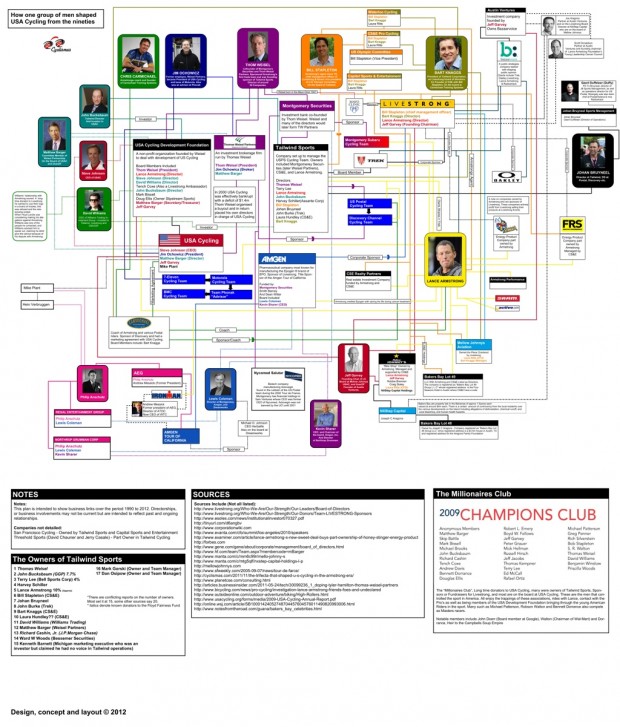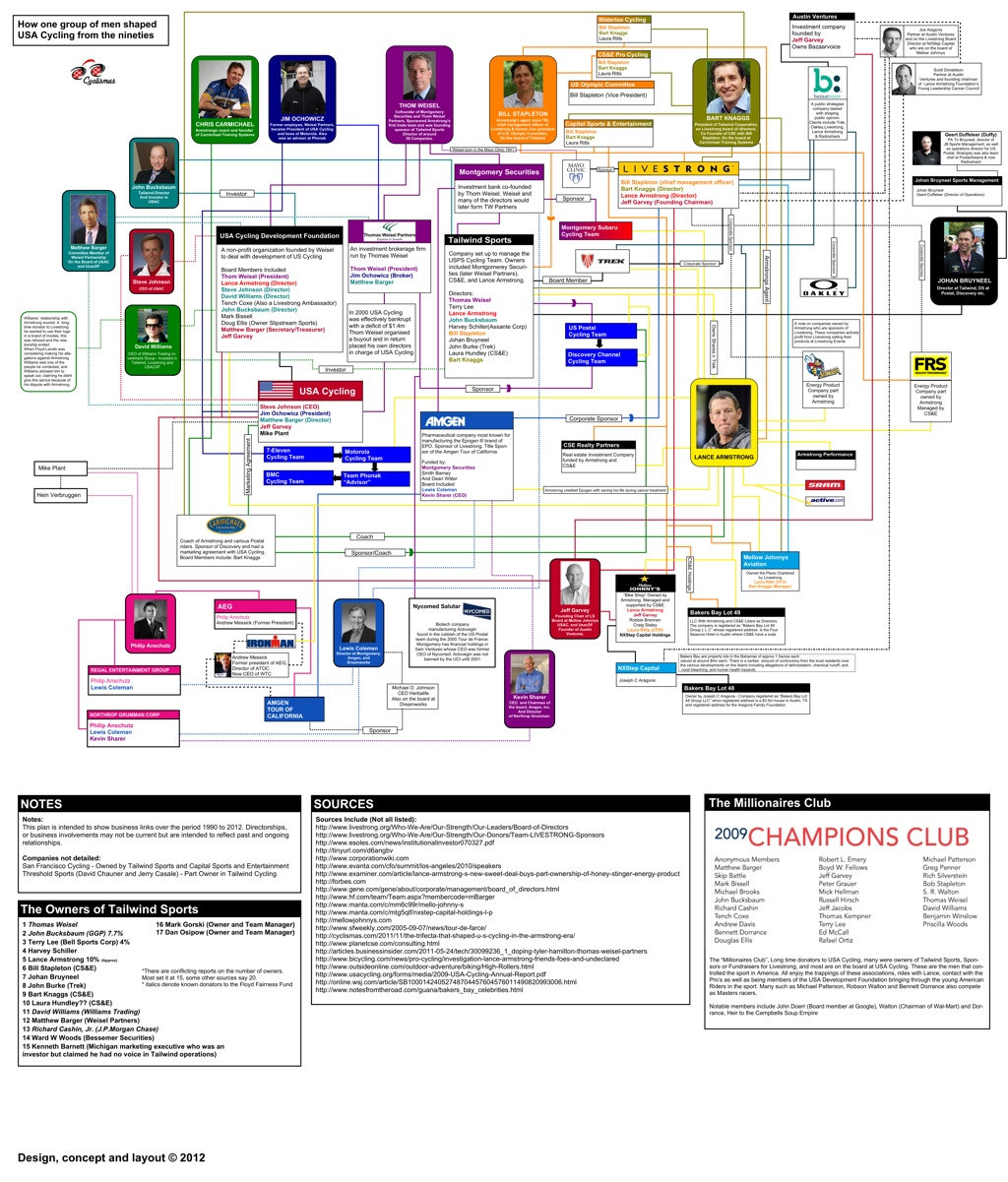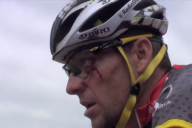Updated 17/7/2012
[Editor’s note] This is a graphic showing how one group of men shaped USA Cycling in the nineties. All the usual suspects are here, along with some other interesting and surprising names, including many of the top power brokers in the United States. The commonality? Lance Armstrong.
Our profound thanks to Dave (@dimspace on Twitter) for the dozens of man-hours he put into this project. Below is a screengrab of the PDF, which measures 45″ x 35″ at full resolution.
Click on the thumbnail image to view it larger on a separate page. Click on it again to blow it up to full screen size.
To download or view the PDF in full 45″ x 35″ resolution, click here and then save the file to your computer.
Note: This chart details business relationships over a period of fifteen to twenty years, and as such may not reflect current relationships or positions.
* * * * *
This is a project I have been thinking about and planning for a while, and now seems a particularly relevant time to put it in the public domain. Many questions have been asked recently; how, if Lance did dope, was it so effectively covered up, where did the funding come from, how is what’s written in the media shaped, and who has the most to lose?
This presentation is not an exhaustive list. There are many more relationships – both personal ones, and business ones – to be explored. The reach of the chart is not just restricted to U.S. Cycling, but worldwide. Some of the business relationships are current, some of them are in the past, but every name on the list has at some point influenced not just the way cycling is run, but also influenced our perceptions of it and what we believe to be true.
To understand how it all works you need to understand some of how it all started. In the beginning there was one man, Thom Weisel, a man with an enthusiasm for cycling, but also an overwhelming determination to win, however that could be achieved. He started small, with the Subaru Montgomery team, and on that team was a young, brash American with potential. With him, Weisel already had a plan to dominate world cycling and most importantly in the eyes of the public, the Tour de France. Lance Armstrong was his name. Armstrong then joined the Motorola team, run by Weisel’s friend and employee, Jim Ochowizc, but it wasn’t all happy sailing. Lance had a reputation as being cocky, arrogant, and difficult to deal with, and eventually the two parted ways with Lance going to the French Cofidis squad.
Weisel’s plan hit a bump. He had the rider, but a rider who was hard, if not impossible to sell to the American public. He didn’t have the charm of LeMond, the press wouldn’t warm to him, and he knew the public would never really take to him. But then, Cancer came along. Suddenly there was a glimmer of hope. Lance was still the brash, cocky rider that people would not warm to, but now he had a story, now he was a survivor, he’d achieved the impossible miracle, and US Postal was born. Livestrong was founded, run by the very same people who would also be part of Tailwind Sports, owners of the US Postal team, and in 1999 after the shadows of the Festina Scandal, Lance won the Tour de France. The survivor, the hero, the anthropologist, had saved cycling.
Meanwhile, Weisel wasnt hanging around, and started to take over US Cycling. First with the development foundation and ultimately with a buyout of USAC, putting onto the board his closest associates, friends, and business partners. A fascinating article by Les Earnest, who attempted to block the moves to takeover the federation, can be found here.
While Mr. Weisel and company have been consolidating their control of USA Cycling and shaping it to suit their interests, he has been less successful in fending off federal investigations of crooked dealings by his investment firm, Thomas Weisel Partners, which has now been forced to pay a $12.5 million fine following a lengthy investigation by the Securities and Exchange Commission. So the world continues to turn and USAC members continue to allow Weisel to run their sport to suit his interests. At least for now.
Pharmaceutical companies, doctors, sports photographers, journalists, public relations companies, coaching companies, energy drinks manufactures, sports companies, race management companies, training companies, property companies, plots of land in the Bahamas, gold mines, aeroplanes, hotels, public strategies companies – the breadth of associations is never ending, and with each new company found, new holding companies, new subsidiaries, and new names get added to the list.
Along the way there have been casualties, notably Floyd Landis and Tyler Hamilton, but also key business investors like David “Tiger” Williams, so long an investor and key part of the organisation, who was one of the first people Landis turned to when he made his allegations against Armstrong. Williams’ advised Landis to speak out (Williams had a falling out with Lance over a merchandising agreement several years previously). The rest is history.
This is far from the end of the story, politicians, majors, medical institutions have all played their part along the way, and without exception, all have something to lose.
















12 Comments
Just a little personal note on all of this.This is a project I have been thinking about and planning for a while and now seems a particularly relevant time to put it in the public domain. A lot of questions are being asked, about how, if Lance was doping, USAC never did anything, or noticed, and its important that people realise just how intertwined everything was back then. Its also relevant when you see situations like Bazaarvoice doing the PR for Lance to understand how that relationship works, how Lance’s companies are involved in the Livestrong brand. Theres a lot of information out there, but only the most serious people will want to read through pages of articles, this is the attempt to make it all a bit clearer. This is only the start of the project, theres a lot more information out there. The consortium that wanted to buy the Tour de France, links to the UCI, Verbruggen and McQaid, the groups use of the media to promote their side of the sport.
Fantastic stuff Dim!
[…] USA Cycling and Lance and the Champiopns Club got in the 90's @dimspace from http://www.velorooms.com has compiled a mind-bending chart of how people, companies and governing body are/were interlinked in th…. Random fact number 1, Thomas Weisel who funded Tailwind Sports, and took over USA Cycling and […]
[…] Lance Armstrong’s Business Links – a flowchart by @dimspace […]
[…] In light of their lost deal worth $250,000 last year due to an AToC snub, I wouldn’t doubt that at all. Make of the situation what you will. I refuse to partake in the near hysterics, but(!) I also can’t fathom promoting a major race where I don’t invite the fourth ranked team on a national calendar. If you feel the urge, or better still, the need, to indulge your inner conspiracy theorist, I suggest you memorize this chart. http://www.cyclismas.com/2012/06/lance-armstrongs-business-links-a-flowchart-by-dimspace/. […]
Fantastic resource. It really helps explain the difficulty in prosecuting Big Tex. It is my impression from the people I know that Lance was receiving experimental oxygen enhancing pharmaceuticals that he never shared with smaller players like George,Tyler, or Floyd. Perhaps RSR-13 from Allos, delivered when needed by someone with access who was not officially affiliated with the team like Carmichael or Roll. By acting as courier none of these super drugs were ever around team mates prying eyes or in the team hotels and vehicles. It seems clear to me It would require multinational pharmaceutical help to make a poor climber like Lance far stronger then natural climbers like Marco who were crushes even when on EPO. This flow chart my be the key to finding that corporate athlete relationship. I think was the point of the Grand Jury..
@ThomasKnox the thought of Bob Roll acting as a courier amuses me. The sad thing is, anything is possible. :S
Congratulations for this work, very enlightening, it reminds of “La Piovra” an old italian series about the “Cosa Nostra”. Armstrong has to go in order for Cycling to survive, but this graph shows clearly how hard that will be. It will be especially difficult to pull the UCI out of this network.
[…] 如果你對他的賺錢網路有興趣,這個網站有幅Lance Armstrong商場關係圖(英文)。不知道完整不完整就是了。 […]
[…] Those lawsuits, perhaps further energized by any acknowledgment of wrongdoing by Armstrong, could take a chunk out of his net worth, often estimated at between $100 million and $125 million. And they could unravel part of the web of holding companies, corporations, and investments the former racer and his partners have assembled over the years — a web that’s too complicated to describe here, but is laid out in a flowchart by Dimspace. […]
[…] Those lawsuits, perhaps further energized by any acknowledgment of wrongdoing by Armstrong, could take a chunk out of his net worth, often estimated at between $100 million and $125 million. And they could unravel part of the web of holding companies, corporations, and investments the former racer and his partners have assembled over the years — a web that’s too complicated to describe here, but is laid out in a flowchart by Dimspace. […]
I really hope and believe that Cycling and the Livestrong Foundation are bigger than one man. The chaff can die without taking the wheat with it, if people act intelligently. Love the diagram, check out my favorite diagram publishing tool <a href=”https://www.lucidchart.com/pages/examples/flowchart_software”>lucidchart</a>you can try it out right in browser